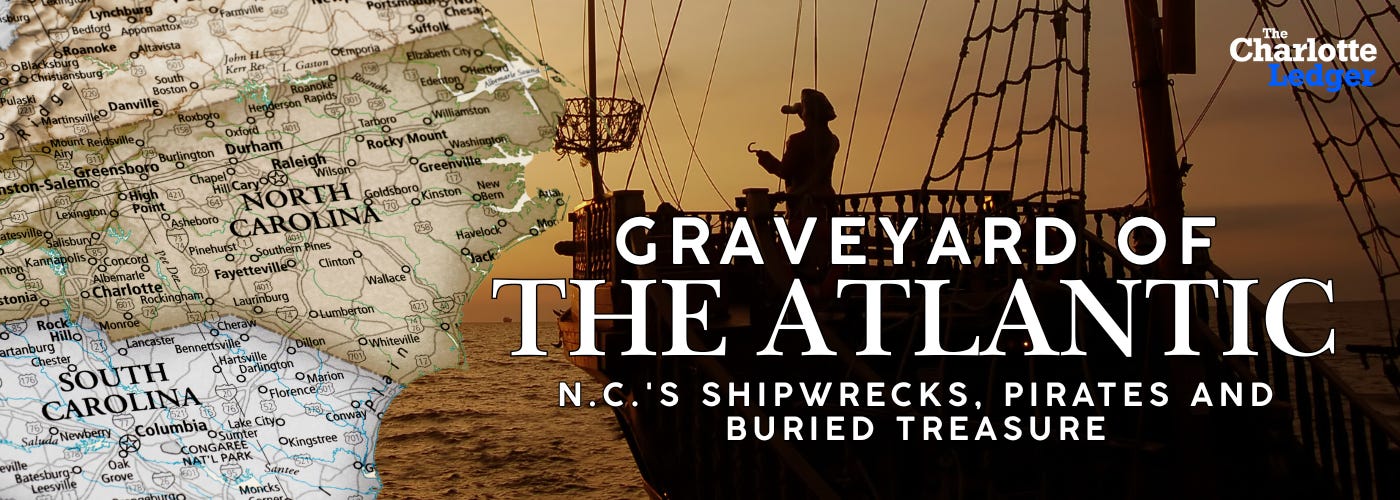When ships burned off N.C.'s coast every night
In early 1942, German subs sank German sank more than 400 vessels off the North Carolina coast — a fiery, forgotten chapter of North Carolina’s wartime history
Off the coast of North Carolina lies one of the world’s most treacherous stretches of sea—a place where shifting shoals, sudden storms, and centuries of shipwrecks have earned it the name “Graveyard of the Atlantic.” In this Charlotte Ledger series, journalist Mark Washburn explores the region’s lore through wartime sinkings, devastating hurricanes, pirate legends, lost treasure and enduring nautical mysteries.
MONDAY: The Mystery of the Ghost Ship Deering: A schooner runs aground with no crew aboard — only clues, whispers and a six-toed cat remain. (🎥 Watch video)
TUESDAY: North Carolina’s Pirate Legacy: Blackbeard’s legend looms large — but how much of it is true, and where’s the treasure he left behind? (🎥 Watch video)
WEDNESDAY: The Tides of War: The quiet beaches of North Carolina once lit up nightly with fire and torpedoes, turning the shoreline into a clandestine battlefield where vessels vanished and history pivoted. (🎥 Watch video)
THURSDAY: The Elusive Treasure: Centuries of shipwrecks — but only one treasure fleet ever made it this far north. Is it still out there?
FRIDAY: Tales from the Depths: From daring rescues and doomed voyages to a storm-sunk movie star, these are the shipwreck stories you’ve never heard — but won’t forget.
The quiet beaches of North Carolina once lit up nightly with fire and torpedoes, turning the shoreline into a clandestine battlefield where vessels vanished and history pivoted
Tanker Dixie Arrow, torpedoed by a German U-boat, sinks off the N.C. Coast in 1942. (U.S. National Archives photo)
By Mark Washburn
Hard to judge, but perhaps the bloodiest chapters in the Graveyard of the Atlantic came in the war years.
Both big wars, World War I and World War II.
You’d think we would have learned from the first conflict, but you’d be wrong.
It even astonished our enemy, the German U-Boat captains. Hunting cargo ships off the Outer Banks of North Carolina, the shooting was fast, easy and decidedly deadly.
Night after night, the sparse population of the Banks could see the burning hulks of transports, sometimes the fireworks of tankers, only a few miles offshore.
And for the war effort, only beginning to stir in North America, each night was a reminder of strength and weakness, ours and theirs.
When the Yanks were drawn into World War I, mostly to deliver a knockout punch to the enemy alliance, historians say, the treacherous seas off the North Carolina coast became a shooting gallery.
Three German subs sank 10 transports off North Carolina with ease. Had the war lasted longer, the toll would have been far greater. They operated with impunity.
But that was just target practice. When the United States was drawn into World War II and Hitler declared war the day after Pearl Harbor, U-boats returned to the happy hunting grounds in the Graveyard of the Atlantic.
Between January and July 1942, German subs sank more than 400 vessels off the North Carolina coast, nearly two a day — ships carrying munitions, oil, food and other vital goods to the European allies, precariously tottering in the balance.
Few people know about it even now.
Keep reading with a 7-day free trial
Subscribe to The Charlotte Ledger to keep reading this post and get 7 days of free access to the full post archives.




